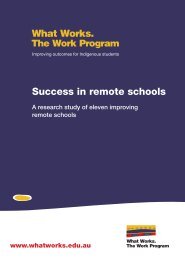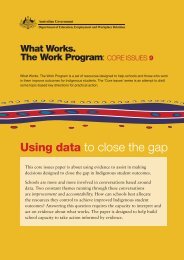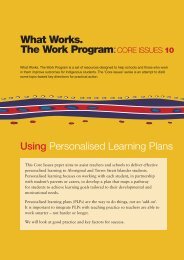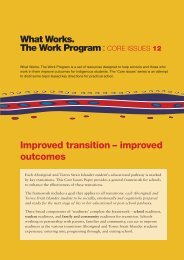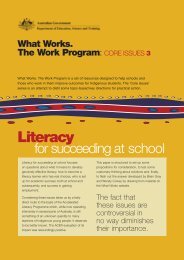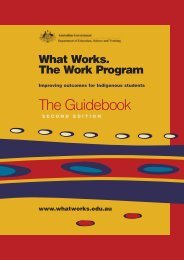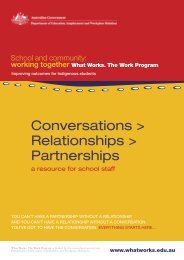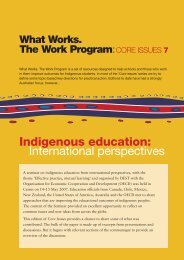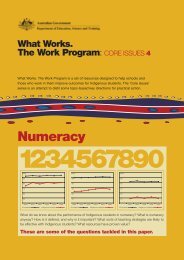Bound for Success Scope and Sequence Statements
Bound for Success Scope and Sequence Statements
Bound for Success Scope and Sequence Statements
- No tags were found...
Create successful ePaper yourself
Turn your PDF publications into a flip-book with our unique Google optimized e-Paper software.
THE ARTSPresents <strong>and</strong> Communicates through <strong>and</strong> in the ArtsConcept In Year 1 In Year 2 In Year 3 In Year 4 In Year 5 In Year 6 In Year 7 In Year 8 In Year 9PresentStudents display <strong>and</strong>per<strong>for</strong>m art works tocommunicate ideasIn Visual Arts thestudent might, <strong>for</strong>example…In Drama the studentmight, <strong>for</strong> example…In Dance the studentmight, <strong>for</strong> example…In Media the studentmight, <strong>for</strong> example…In Music the studentmight, <strong>for</strong> example…(note this is KLAMusic, not SpecialistMusic Program)Students expressthemselves spontaneouslyin play <strong>and</strong> use play as thebasis <strong>for</strong> sharing art works.• Choose <strong>and</strong> presentdifferent colours <strong>and</strong>shapes to represent real<strong>and</strong> imagined images (e.g.choose different coloured<strong>and</strong> sized circles torepresent flowers <strong>and</strong> linethem up across the page ontop of h<strong>and</strong>-drawn stems).• Spontaneously pretend tobe someone else (e.g.pretend to be a young childfinding their way out of ascary bush) even whenthey notice the teacher iswatching.• Pretend to be an animalstalking prey while theysway to some music <strong>and</strong>say that is what they aredoing.• Collect <strong>and</strong> share mediaproducts (e.g. play in their‘home corner’ with theirBig Bird doll, making thedoll move in the sameways that the mediacharacter moves).• Per<strong>for</strong>m Looby Loo byplacing the ‘body parts’ inthe same order as the textof the song (right leg, leftleg, right arm, left arm,head, whole self)Students express their ownfeelings through the arts byexploring <strong>and</strong>experimenting with a rangeof mediums <strong>and</strong> respondsin simple ways to anin<strong>for</strong>mal audience.• Draw a picture using warmcolours to express feelingsof happiness <strong>and</strong> joy <strong>and</strong>say “this shows me beinghappy”.• Pretend to be anothercharacter (in role playsstructured by the teacher)<strong>and</strong> respond to theaudience by talking loudly<strong>and</strong> st<strong>and</strong>ing up so thatother classmates can see<strong>and</strong> hear what ishappening <strong>and</strong> bowingwhen they are applauded.• Move in different ways inresponse to differentfeelings (e.g. sway slowly<strong>for</strong> tiredness, jump <strong>and</strong>skip <strong>for</strong> joy, thrash around<strong>and</strong> hit the air <strong>for</strong> anger).• Place a favourite mediadoll/character (e.g.Superman) in front of aposter showing buildingsthat they created as abackdrop <strong>and</strong> arrangingthe doll horizontallysaying to those watching:“he is flying”.• Hum, whistle or sing‘twinkle, twinkle littlestar’ loudly so everyone inthe class can hear but thensing it softly so only theirpartner can hear, saying“you have to sing louder<strong>for</strong> more people becausethey’re further away”).Students display <strong>and</strong>per<strong>for</strong>m art works infamiliar <strong>and</strong> in<strong>for</strong>malcontexts (own family, classgroup) <strong>for</strong> personal,creative expression drawingon personal experience <strong>and</strong>what they’ve observed.• Make a card <strong>for</strong> theirMum/Nanna/Auntydrawing a picture offlowers on the frontbecause they know shelikes flowers.• Take on the character (inrole-plays structured bythe teacher) by respondingto specific nuances of therole based on what they’veexperienced or observed(e.g. when the friendlyalien tells them that it isdifficult to breathe on theplanet, they stagger, holdtheir throat <strong>and</strong> ask thealien to help them).• Communicate events fromhome or school in asequence of movements(e.g. arriving at school,coming into class, puttingpens on the desk).• Display or publish theirmedia products (such asphotos they took of theCroc Festival) onclassroom, library <strong>and</strong>school noticeboardswriting captions to ensurepeople stop <strong>and</strong> look.• Sing or play a short tunethey made up of first linesfrom various songs in asequence using songs thatthe class are familiar withor enjoy.Students present art worksto a familiar audience <strong>for</strong> aparticular event designed toentertain, selecting display<strong>and</strong> per<strong>for</strong>mancetechniques from specific<strong>for</strong>ms <strong>and</strong> <strong>for</strong>mats.• Paint a picture to hang inthe classroom about therodeo (or other communityevent) <strong>and</strong> then choose tomount it <strong>for</strong> hanging on aseparate piece of paper,explaining why (e.g. say Iput my picture on a redpiece of paper becausethere is red in the picture<strong>and</strong> the red makes thegreen grass st<strong>and</strong> out”).• Speak <strong>and</strong> move asrequired by the dramaticaction (e.g. select shortmoments or sequencesfrom the hospital dramathey previously developed,<strong>and</strong> share with others).• Develop <strong>and</strong> present totheir class a short dancesequence mimicking oneof the acts at the CrocFestival after firstdescribing what they saw<strong>and</strong> observed.• Design a presentation <strong>and</strong>post it to the schoolwebsite - loading photos,sounds <strong>and</strong> captions - toshare the events of a recentschool excursion to therodeo or other event. Uselong shots to establish thesetting, close-ups <strong>for</strong>emotion <strong>and</strong> action shots<strong>for</strong> interest.• Put together <strong>and</strong> per<strong>for</strong>m asmall repertoire of songsor pieces to entertain thejunior school, choosingsongs or pieces that willengage their audience,including an interactivepiece, <strong>and</strong> saying why.Students present art worksto an audience beyond theschool <strong>for</strong> a particularevent, using a range ofdisplay <strong>and</strong> per<strong>for</strong>mancetechniques.• Make a collage torepresent ‘the wet’ to hangin the community,choosing to use naturalmaterials such as s<strong>and</strong> <strong>and</strong>seaweed <strong>and</strong> explain whyin context (e.g. say “I usedthe s<strong>and</strong> <strong>and</strong> seaweed tomake it more real <strong>and</strong> weglued them onto thestraight lines to make itlook like moving water”).• Present their own shortskit at a public concert;speaking <strong>and</strong> moving asthe dramatic action require(e.g. speaking in adistorted voice <strong>and</strong> movingas if they were free ofgravity in one part of theskit, <strong>and</strong> walking <strong>and</strong>talking normally inanother).• Present a structured dancewith a beginning, middle<strong>and</strong> end, that theydeveloped, usingtraditional (Aboriginal orIndian) dance styles <strong>for</strong> apublic concert.• Display posters <strong>and</strong>brochures they created,<strong>and</strong> play a video theymade at their localcommunity centre toadvertise their CrocFestival per<strong>for</strong>mance orpromote their water safetyvideo• Put together <strong>and</strong> per<strong>for</strong>m arepertoire of songs orpieces <strong>for</strong> a communityconcert to demonstratetheir versatility <strong>and</strong> toentertain a wide variety ofages <strong>and</strong> tastes.Students present art worksto an audience beyond theschool <strong>for</strong> a particularevent designed with a clearcommunication purpose,(showing a willingness torehearse to developtechnical proficiency).• Make a collage usingdigital photographs <strong>for</strong> acommunity competitionwith a theme of‘technology in the arts’<strong>and</strong> practice distortingtheir photos be<strong>for</strong>eselecting the ones they willuse, justifying their choicein the context of what theyare communicating.• Rehearse moments <strong>and</strong>scenes of a play,memorising lines to ensurethat significant lines in thescript are prominent <strong>and</strong>pronounced.• Put together a class dance<strong>for</strong> the Croc Festival toraise money <strong>for</strong> victims ofa cyclone <strong>and</strong>communicate the need <strong>for</strong>‘caring <strong>and</strong> sharing’through their dancemovements.• Develop <strong>and</strong> distributebrochures made usingpublisher to promote watersafety, distributing a‘mock up’ to the schoolcommunity to obtainfeedback prior todistributing to the widercommunity.• Per<strong>for</strong>m a song or piece asan opening <strong>for</strong> an eventsuch as a town meeting todiscuss water shortages<strong>and</strong> choose a song thatrelates to the issue.Students present art worksto audiences within <strong>for</strong>malcontexts <strong>for</strong> a particularpurpose, collaborativelydeciding on what to presentor per<strong>for</strong>m to fit the context(showing a willingness torehearse to developtechnical proficiency <strong>and</strong>seek instruction <strong>and</strong>direction in order topersonally improve).• Collaborate with others todesign a 3D sculptural<strong>for</strong>m which will enhance alocal area (e.g. a sculpture<strong>for</strong> the front entry of thecouncil building) <strong>and</strong>explain why they chose the<strong>for</strong>m/texture (e.g. say “weused a rough surfacebecause we wanted torepresent the struggles ofthe Indigenous people intheir fight <strong>for</strong> equality”).• Present a dramatic play <strong>for</strong>a local concert, refining<strong>and</strong> reworking scenes atrehearsal collaborativelywith peers, sustaining theirrole by concentrating onthe action <strong>and</strong> staying incharacter when notspeaking.• Collaborate to present adance sequence thatexplores a theme (e.g. adance <strong>for</strong> NAIDOC Weekor the ‘Coming of theLight’ that presents thetheme of reconciliation).• Use industry practices topublish media products ina specific context (e.g.collaboratively publish <strong>and</strong>display CDs, videos <strong>and</strong>digital photos, about alocal environmental issuesuch as Sea Grass Watersin local communitywebsites, newsletters <strong>and</strong>noticeboards targetingfamilies with youngchildren).• Sing or play a repertoire<strong>for</strong> a concert to raisemoney <strong>for</strong> a worthy causein an old people’s home,choosing songs from thewar years <strong>and</strong> attendingrehearsals to improve theirper<strong>for</strong>mance.Students present art workswithin <strong>for</strong>mal <strong>and</strong> artsindustry contexts using arange of <strong>for</strong>ms <strong>and</strong> <strong>for</strong>matsincluding new <strong>for</strong>ms ofexpression <strong>and</strong> indicatewhy these weretried/incorporated.• Make a painting <strong>for</strong> anexhibition using paint <strong>and</strong>charcoal applied first <strong>and</strong>covered in a water-colourwash saying “I wanted it tolook wet <strong>and</strong> this effectwas the best one that Itried”.• Present a group-deviseddrama <strong>for</strong> a communityaudience about familiesliving in the city based ona magazine article saying“we chose to use paceembedded in variousmovements to give animpression of the hustle<strong>and</strong> bustle of city life”.• Present a group-deviseddance at an event such asthe Croc Festival, showcasingindividual styles<strong>and</strong> using solo <strong>and</strong> groupdances, saying “wecontrasted the differenttypes of dance styles <strong>and</strong>used them all in aconnected way”.• Create a webpage usinghyperlinks <strong>and</strong> ‘grabs’saying “we used hyperlinks<strong>and</strong> grabs to incorporatesound to heighten theimpact of the images”.• Per<strong>for</strong>m a program ofmusic including somethingcompletely different to thenormal style, saying “Iplayed it like a blues piecejust to try somethingdifferent” or “I arrangedthat waltz tune so that itwould sound like amarch”.Students display <strong>and</strong>per<strong>for</strong>m art works in arange of school,community, <strong>and</strong> artsindustry contexts, choosingworks designed to blend,surprise, entertain orchallenge <strong>and</strong> justify theirchoice.• Use images from severalsources such as computerimages <strong>and</strong> photo copier asthe basis <strong>for</strong> an art work aspart of a communitydisplay about climatechange <strong>and</strong> say “I usedblack <strong>and</strong> white pictures toshow the starkness of theenvironment as if all thecolour <strong>and</strong> life was gone”).• Develop <strong>and</strong> per<strong>for</strong>m amime or short play thatchallenges perceptionsabout disability, racism orsome other issue thatcrosses cultures <strong>and</strong> say“we used mime so thatlanguage wouldn’t stopsome people from knowingwhat we wanted to say <strong>and</strong>everyone watching wouldget the message”.• Develop <strong>and</strong> per<strong>for</strong>m adance exploring differentways of expressing thesame idea (e.g. a dancedemonstrating how ‘thewet’ affects differentmembers of thecommunity).• Exhibit media products incontemporary, publiccontexts <strong>for</strong> particulareffect (e.g. collaboratewith a local communitygroup to distribute leaflets<strong>and</strong> set up campaigndisplays explaining stemcell research, saying“leaflets provided us witha <strong>for</strong>mat <strong>for</strong> a short, sharpmessage about stem cellresearch; we used a photoof a dog with 2 heads toget their attention”).• Write music to accompanya silent movie, matchingthe mood to the musicsaying “we used the music<strong>for</strong> dramatic effect havingloud bangs when thingsdropped, fast music duringa chase <strong>and</strong> slow,romantic music during thelove scenes”.<strong>Bound</strong> <strong>for</strong> <strong>Success</strong> <strong>Scope</strong> <strong>and</strong> <strong>Sequence</strong> <strong>Statements</strong> V2 Page 78 Working Document Semester One 2007



